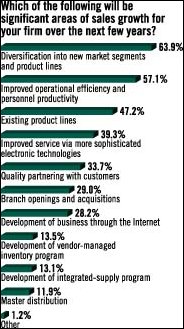
Unless, of course, you're in the industrial-PVF business. The stainless-steel market is beginning to show signs of life again after an extended and deep hibernation, so maybe it was a collective sigh of relief from stainless distributors that inflated the positive data from PVF wholesalers responding to our 1999 Industrial PVF Survey. Or maybe many are thinking so positively that they can't bear to admit the truth. Or only the PVF wholesalers who are having a good year responded; the rest don't want to talk about it.
Whatever the explanation, the numbers don't tell the whole story, according to distributors who are willing to talk about it. A survey follow-up, largely through conversations at the American Supply Association convention last month, brought responses from a polite "Things could be better" to an emphatic "The market sucks!"
The dichotomy between distributors' informal comments and the survey results presents a real dilemma to the editors of this magazine. Traditionally we analyze the data presented to us by the professional researchers who conduct the survey. This year, however, the generally negative responses to the question "How's biz?" have made us take a puzzled and very hard look at the numbers: If business is so lousy, how come nearly two-thirds of all respondents say sales are up?
One possible explanation: The blistering pace of residential construction has dazzled the view of wholesalers who deal in plumbing, heating and cooling as well as industrial PVF. We asked respondents to break out the results for PVF from the rest of their business for the survey, but perhaps many did not.
In fact, when we separated companies for whom industrial PVF comprises more than 50% of their business, the percentage reporting an increase during the first half of 1999 over the first half of 1998 dropped from 61.3% to 56.7%.
So we got on the phone and ran our theory past some veterans of the industry, none of whom were surprised by our skepticism. Joel Becker, president of Torrington Supply in Waterbury, Conn., and chairman of ASA's Industrial Piping Division, agrees that the demand for plumbing-related products has not lifted all boats.
"Traditional industrial PVF seems to be flat, at least in my small market," he says. "Friends in the business tell me it's a soft market for them, too. Business to mechanical contractors and plumbers is good, but business to industry is lousy."
A West Coast PHCP executive, who asked not to be identified, suggests that "a huge margin squeeze" could be causing the perception that business is poor despite positive numbers. "When you look at sales volume, it appears that business is up. But the contribution of the industrial-PVF sector to the bottom line isn't as great as it used to be."
Peter Shillingford, president of Giant Plumbing & Heating Supply, points to the continuing cutbacks in the automotive industry as a negative influence in his Detroit market. "The margins are already awfully tight, but everyone is trying to get on the bus for what business there is," Shillingford says. "Not everyone will make it. Medium-sized companies like ours are in the most precarious position."
However, F.W Webb's industrial-PVF market is thriving, largely due to efforts to increase market share, especially among mechanical contractors, says Ernie Coutermarsh, vice president/industrial sales for the Burlington, Mass.- based distributor.
"We have an initiative to capture a large percentage of the mechanical-PVF business, which wasn't a high priority for Webb in the past," he says. "The mechanical market is really driven by price, so we try to be their single-source solution. We can deliver everything mechanical contractors need on one truck."
Webb's new emphasis on mechanical contractors reflects a trend reported by 63.9% of survey respondents, who expect their biggest sales-growth opportunities over the next several years to come from diversification into new market segments and product lines. Another 59% are looking to improved operational efficiency and productivity to make the most of margins that will undoubtedly continue to contract.
Judging from the survey, PVF distributors are an optimistic bunch. More than 65% expect business to increase an average of 12.5% in the last half of this year. In the last two years, only about 57% expected second-half improvement. The Internet is becoming more of a player in PVF distribution. Last year fewer than 42% said their companies had Web sites; this year 50.6% had them. Almost 48% say they are doing business over the Net. Another 28% expect to be within a few years.
Kevin Rosenthal, director of sales and marketing at A&M Industrial Supply (Rahway, N.J.) believes that leading-edge, if not bleeding-edge, thinking will be key to success - and probably survival - in the PVF business over the next several years.
"Companies that provide total solutions are increasing business," he notes. "As a whole, business is soft. But companies that have made the investment in technology, engineering and technical staffs and value-added services to provide a total solution are really in favor today. It's a given that you have to work long and hard. The secret is to work smart."
